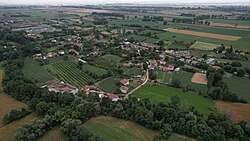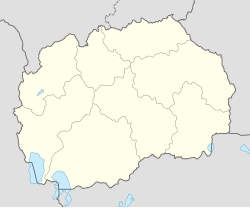Porodin, North Macedonia
Porodin | |
|---|---|
Village | |
| Породин | |
 Air view of the village | |
| Coordinates: 40°56′N 21°22′E / 40.933°N 21.367°E | |
| Country | |
| Region | |
| Municipality | |
| Population (2002) | |
• Total | 202 |
| Time zone | UTC+1 (CET) |
| • Summer (DST) | UTC+2 (CEST) |
| Car plates | BT |
| Website | . |
Porodin (Macedonian: Породин, Albanian: Porodin) is a village in the municipality of Bitola, North Macedonia. It used to be part of the former municipality of Bistrica.
History
[edit]Porodin contains two major archaeological sites within its boundaries. Bara Tumba, a Neolithic settlement, was discovered in 1953 and its findings are kept at the Institute and Museum Bitola.[1] Veluška Tumba is also a Neolithic site.
Demographics
[edit]According to the 1467-68 Ottoman defter, the village had 68 houses, 4 bachelors and 8 widows. Some of the heads of families had traditional Albanian names, such as the following: Gjin Arnaut (t. Arbanas), Goja son of Vilan, Koja (Goja) son of Nikola, Koja son of Dragusha, Lazor Koja, Dimitri son of Koja ( Goja).[2]
In statistics gathered by Vasil Kanchov in 1900, the village of Porodin was inhabited by 300 Christian Bulgarians and 190 Muslim Albanians.[3] According to the 2002 census, the village had a total of 202 inhabitants.[4] Ethnic groups in the village include:[4]
- Macedonians 194
- Albanians 6
- Others 2
References
[edit]- ^ Dimče, Kočo (1996). Археолошка карта на Република Македонија. стр. 248, Скопје: МАНУ. ISBN 9789989101069
- ^ Rexha, Iljaz (2012). "POPULLSIA ALBANE GJATË MESJETËS NË HAPSIRËN E MAQEDONISË SË SOTME" (43): 24.
{{cite journal}}: Cite journal requires|journal=(help) - ^ Vasil Kanchov (1900). Macedonia: Ethnography and Statistics. Sofia. p. 236.
- ^ a b Macedonian Census (2002), Book 5 - Total population according to the Ethnic Affiliation, Mother Tongue and Religion, The State Statistical Office, Skopje, 2002, p. 70.
External links
[edit]

